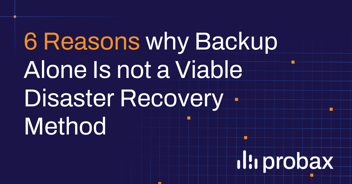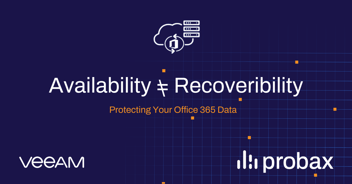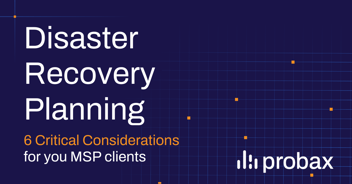There continues to be a misperception that backup-based disaster recovery (DR) is an adequate recovery solution for end-user businesses.
The reality couldn’t be further from the truth.
MSPs that offer backup-based disaster recovery solutions ultimately need to recover their customer’s environment in the cloud using backup images. When a MSP is using a vendor’s backup-based DRaaS solution, the manual recovery process is usually performed by the vendor.
Either way, this has enormous consequences on the end user business and may have revenue loss consequences. That’s because it takes considerably longer to fail over and fail back from image-based backups compared to a true DRaaS solution that regularly replicates an environment to a provider’s cloud.
This means that MSPs providing replication-based DR are delivering a significantly better business outcome than providers who only offer backups and/or DR solutions based on backups.
Let's compare disaster recovery that is based on backups vs disaster recovery that is based on replication.
Comparing DR based on Backups vs DR based on Replication
Defining backup and replication
Backup involves making a copy or copies of data.
Replication is the act of synchronizing systems and data between a company’s production and recovery sites - the latter usually being in the cloud. It is typically measured with RTO and RPO.
What is the purpose of backup and of replication?
Backup focuses on compliance and granular recovery, and is a snapshot of data at a point in time.
Replication and recovery focus on delivering adequate Disaster Recovery, minimizing RTO and enabling fast failover and failback to resume operations after an outage.
What are the uses of backup and replication?
Backup is typically used for everything in the enterprise, from critical production servers to SaaS applications.
Replication is often used for mission-critical applications that must always be up and running.
What are the requirements?
Backup requires an external storage repository or appliance for onsite backups (usually a Server, NAS or SAN). Offsite backups are usually stored in the cloud or on tape.
Replication requires investment in secondary infrastructure in order to enable recovery and continued business operations.
How do they work?
Backup typically relies on snapshots which are copies of the data set taken at a pre-determined point-in-time.
Replication can be Synchronous, Asynchonous or Near-Synchronous and may use Continuous Data Protection to enable users to access historic data.
How do they impact the bottom line?
Backup is a relatively inexpensive way to avoid complete data loss. Valuable for non urgent data recovery and compliance. Does not ensure continuity of operations.
Replication is focused on ensuring that business applications and business-critical data are always available, even after a disaster. DRaaS is 30-50% of the cost of traditional DR and a fraction of the cost of the cost of downtime (up to $26,000 per hour).
Is data backup the same as disaster recovery?
Backup is not true disaster recovery. It's just one element of a complex disaster recovery process. Data backup serves as a copy of a company's data, and it's meant to protect you against the loss of data within your everyday systems.
In the event of a disaster, you would have to restore your backups from a backup server or media but the process can take too long. Meanwhile production data is being lost.
DRaaS is a true disaster recovery solution that minimizes downtime. A DRaaS provider's technology takes care of your data and applications by creating a complete replica solution in the cloud to ensure data availability and continuity of critical business operations.
Failing over to a cloud environment to keep operations running and failing back to primary production quickly results in minimal data loss.
The case for Disaster Recovery based on replication
Given the problems of automation, poor RPO/RTO targets, and limitations in recovery points, what would be a superior DR alternative to backups that address these issues? For many businesses, the answer is replication, the process of replicating and then transferring data across one or more recovery sites, such as a dedicated DR site or cloud infrastructure.
Replication is a blanket term for a variety of methodologies, but they all have in common the ability to capture your system’s data, detect changes to data as they happen, and reproduce these changes at recovery sites. This allows for several benefits over traditional backups for DR purposes.
Better backup and performance recovery
Because replication doesn’t capture all your data at once, but rather only synchronizes what has been changed, it takes up less storage and CPU resources than initiating a backup.
It also allows you to maintain continuity in case of a disaster—if one site fails, your system may automatically failover to the next replication site with little to no downtime.
Improved granularity of backup snapshots
As mentioned, increasing the interval of backup snapshots can exert a significant strain on your processing capacity and contribute to reduced performance. This is why in most cases, you may only select from 12-24 hour intervals. Meanwhile, replication allows for a vastly increased granularity of restoration points because they are created at the file or even block level, depending on the technology used. This helps you meet much tighter RPO metrics, oftentimes in the order of minutes or even seconds.
For Tier 1 mission critical applications, RTO/RPOs can be less than 15 minutes with Veeam replication.
Why are Probax and Veeam better together for disaster recovery?
Veeam offers DRaaS as part of a complete availability solution, offering a consistent user experience and lowering the overall cost to safeguard a company's data.
Veeam's image-based replication delivers natural disaster recovery at an SME-friendly price. It's straightforward and uncomplicated to use with no hidden costs or complex licensing constraints. Their solution is efficient, cost-effective, and agnostic storage, application, and operating system.
Veeam Backup & Replication gives businesses the ability to monitor and protect their data. Its global availability and scalability have made it a favorite among organizations of all sizes worldwide.
The solutions are MSP ready and are a tried and tested way for MSPs to provide DRaaS.
Whether you're a managed services provider (MSP) reselling Veeam Cloud Connect or an MSP that wants to take advantage of Probax Hive to centralize and transform how you provide DRaaS for your clients, you can use the same proven platform, with no work required.
You need DRaaS in your MSP toolkit
Traditional backup only protects a segment of data. That's why our practical and free white paper Most MSPs Have Inadequate Disaster Recovery Solutions outlines everything your MSP needs to know about the importance of DRaaS.
Simply click below to download your copy today!






